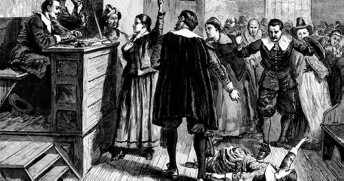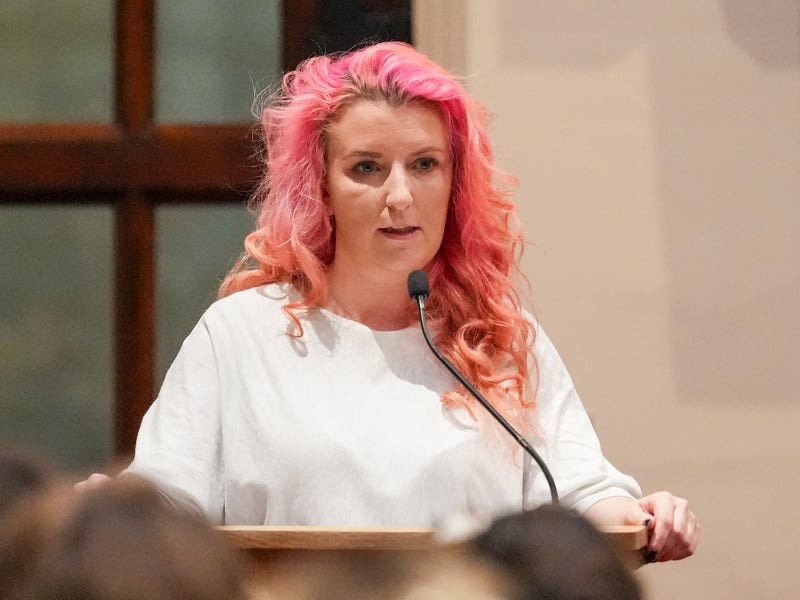The stereotype of the old woman with her cat, gingerbread house and broomstick has been with us in many forms for centuries and most cultures seem to have developed their own version of the typical witch.
For example Baba Yaga, a terrifying witch from Russian and Slavic folklore, rides around in a giant pestle and mortar and eats children.
In Jersey many legends of witches centre on Rocqueberg, or the ‘witches rock’, located near Green Island in St Clement. Folklore tells us that witches congregated at the rock and raised storms with their songs, forcing fishermen passing by to pay tribute or risk their boats being dashed on the rocks. The headland of Rocqueberg apparently still has the imprint of a cloven hoof, from an encounter between fair Madeleine and satanic Hubert, who she fought off with a cross.
But what of the real witches? The witchcraft phenomenon was widespread during the 16th and 17th centuries and had a large impact in Jersey where, between the trial of Anne of St Brelade in 1562 and that of Marie Godfray in 1736, at least 66 people were accused of witchcraft. Interestingly one of the famous Salem ‘witches’, Philippe d’Anglois/English, also had a Jersey link. Philippe was apparently born in Jersey of Huguenot descent and emigrated to Salem in the 1670s.
Jersey Archive staff have been researching records relating to witchcraft trials held in Jersey and have found some interesting examples of prosecutions in the court records held at the archive. These show that some widespread beliefs about who the witches were and what happened to them may not be quite as true as once thought.
It is a common misconception that witches were old women who had been ostracised from society. In Jersey witches came in multiple guises – they could be old or young, male or female and from various positions in society. Michelle Cosnefrey was aged around 80 at the time of her trial while some of those accused of witchcraft were probably no more than teenagers.
In Jersey several of the accused were male, a good example being Symon Vauldin of the Parish of St Brelade. He confessed to having had familiar communication and conversed with the devil, at different times, when he appeared in the form of a cat and then a raven, or possibly a crow. Several witnesses testified that Symon was a sorcerer of great evil and he was summarily executed by strangling and then burning.
Particular families seem to have been accused of witchcraft over a number of generations, with the Alixandre/Alexandre, Grandin and Tourgis families coming in for particular scrutiny. Marie Tourgis was tried twice for witchcraft and finally executed.
Those accused of witchcraft were not necessarily from families with bad reputations. Marie Esnouf, who was executed in June 1648, was actually the granddaughter of the Rector of St John. As a clergyman he would have been expected to take a stance against witchcraft in the community.
There is no evidence of a trial in this case but it strongly suggests that allegations of witchcraft were continuing well into the 18th century and that the church in this case took a more enlightened and sympathetic attitude.
While no legal trial took place in the case of Elizabeth Gavey, a number of witch trials are recorded in the Cour de Cattel books at the Jersey Archive.
From these sources we can recreate what happened to the accused witches after their arrest. Firstly the accused was placed in Mont Orgueil Castle on a diet of bread and water. Once a trial had been set the witch had the chance to reject any jurors that she or he didn’t consider suitable.
The system seems to have fallen down if the witch was clever enough to keep rejecting the jurors and could stand the near starvation diet. Perrine Alixandre the wife of Estienne Bertault, spent a year in the castle and still refused to accept her jurors. Eventually the court gave up and she was released with a warning.
Once a case came to trial witches were condemned after the finding of a witch’s mark upon the skin, which was sometimes hidden in places that were hard to find. This mark was often pricked with a needle to see what reaction was caused. Marie Esnouf had a mark on the soft palate of her mouth, which was pierced with a lancet but did not bleed or cause her pain.
Other printed accounts of witchcraft trials in Jersey refer to the possibility of a trial by ordeal, whereby the accused was made to pick up either a hot stone from the bottom of a pot of boiling water or to carry a red-hot iron for a certain distance. The hand was then bandaged and after a set period the bandages were removed. If the wound had healed the person went free, but if it was blistered then the person was guilty.
A popular misconception is that all witches were burned at the stake. In Jersey the appropriate course of action was to hang or to strangle the accused before burning the body. The following account is from the Cour du Cattel registers:
As this example shows, the property of those found guilty of witchcraft could be confiscated. Marion Corbel died in the castle awaiting trial and her relatives made a claim for her property, saying that without a trial she had not been found guilty. The court, faced with losing the revenue from her goods, declared her guilty in absentia and her relatives received nothing.
From the research we have conducted it would appear that no particular section of Jersey society, rich or poor, male or female, was protected from a witchcraft accusation. Much of the evidence does appear to have been based on the testimony and hearsay of neighbours, who may have had their own reasons for making a false allegation. Occasionally those accused had the sheer bad luck of having a hidden birthmark that was only revealed under very close examination.
Whatever the reason for an accusation of witchcraft, the witches and witch trials were very much a factual part of Jersey life in the 16th, 17th and 18th centuries. Fictional stories and rumours of witches exploits still do form part of Island folklore, but the fact remains that a good many people in Jersey died for their supposed crimes.
• To find about more about the Island’s witches visit the Jersey Archive.
The St Brelade record of Symon Vauldin who confessed to communicating with the devil






